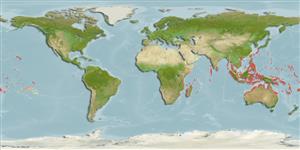Common names from other countries
>
Blenniiformes (Blennies) >
Blenniidae (Combtooth blennies) > Salariinae
Etymology: Entomacrodus: Greek, ento = inside + Greek, makros = big + Greek, odous = teeth (Ref. 45335).
More on author: Valenciennes.
Environment: milieu / climate zone / depth range / distribution range
Ecologia
marinhas associadas(os) a recifes; intervalo de profundidade 0 - 3 m (Ref. 86942). Tropical; 30°N - 32°S
Indo-Pacific: East Africa to the Line and Ducie islands, north to the Ryukyu, Bonin, and Marcus islands (reported farther north to Wakayama Prefecture in Japan, Ref. 559), south to Lord Howe and Rapa islands.
Tamanho / Peso / Idade
Maturity: Lm ? range ? - ? cm
Max length : 11.0 cm TL macho/indeterminado; (Ref. 9710)
Descrição suscinta
Chaves de identificação | Morfologia | Morfometria
Espinhos dorsais (total) : 12 - 14; Raios dorsais (total) : 14 - 16; Espinhos anais: 2; Raios anais : 15 - 18. Small dark spots on body; upper lip uniformly dusky or with scattered spots; pale area behind eye followed by an irregular dark mark (Ref. 4404).
Facultative air-breathing (Ref. 126274); Adults occur in the intertidal zone of lagoons and wave-swept seaward reefs (Ref. 9710). They inhabit holes of limestone matrix at low tide (Ref. 90102). At low tide they may be found in small pockets of water left in pitted limestone. Oviparous. Eggs are demersal and adhesive (Ref. 205), and are attached to the substrate via a filamentous, adhesive pad or pedestal (Ref. 94114). Larvae are planktonic, often found in shallow, coastal waters (Ref. 94114).
Ciclo de vida ou comportamento de acasalamento
Maturities | Reprodução | Spawnings | Egg(s) | Fecundities | Larvas
Oviparous, distinct pairing (Ref. 205).
Myers, R.F., 1991. Micronesian reef fishes. Second Ed. Coral Graphics, Barrigada, Guam. 298 p. (Ref. 1602)
Status na Lista Vermelha da UICN (Ref. 130435)
CITES (Ref. 128078)
Not Evaluated
Ameaça para os humanos
Harmless
Uso pelos humanos
Pescarias: espécies comerciais; Aquário: Espécies comerciais
Ferramentas
Relatórios especiais
Baixar XML
Fontes da internet
Estimates based on models
Preferred temperature (Ref.
115969): 24.9 - 29.3, mean 28.4 (based on 2647 cells).
Índice de diversidade filogenética (Ref.
82804): PD
50 = 0.5000 [Uniqueness, from 0.5 = low to 2.0 = high].
Bayesian length-weight: a=0.00741 (0.00335 - 0.01640), b=3.02 (2.83 - 3.21), in cm Total Length, based on LWR estimates for this (Sub)family-body shape (Ref.
93245).
Nível Trófico (Ref.
69278): 2.0 ±0.00 se; based on food items.
Resiliência (Ref.
120179): Elevada, tempo mínimo de duplicação da população menor que 15 meses (Preliminary K or Fecundity.).
Fishing Vulnerability (Ref.
59153): Low vulnerability (10 of 100).
